Crisp chip-bag coding at 140 bpm
January 30, 2014
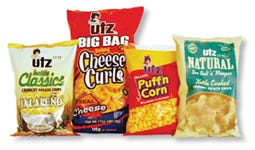
Times are changing again at Utz Quality Foods, one of the nation's leading regional snack food manufacturers. When Utz got its start in 1921, William and Salie Utz produced potato chips in their summer kitchen at a speed of 50 lb/hr. Today, it can pack about 1 million packages a day. In the mid-1970s, Utz began to expand its offerings, which today include pretzels, corn chips, popcorn, cheese curls and other tasty treats. At various times of the year, the company also offers snack and party mix product combinations.
Recently, the privately owned and family-oriented company based in Hanover, PA, made a move to thermal-transfer overprinting as the coding method for its primary packages of salty snacks. The reason was simple: It could realize a 33-percent savings on maintenance and reduce its downtime for code changes. For machine operators, the printing decision is a real time saver, as a code-block change used to take the company a minimum of five minutes, which could become costly downtime for a production line marking 100 to 140 potato chip and snack bags/min. Changing a code before thermal-transfer printers were added to the plant required the assistance of tweezers and wrenches, which only increased the tediousness of the task. If a code was printed incorrectly, the misprinted bags had to be destroyed, and the product had to be repackaged, racking up waste in both materials and time.
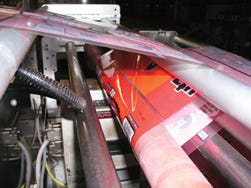
That's no longer a problem, thanks to the DataFlex(R) and DataFlex Plus thermal-transfer overprinters from Videojet Technologies, Inc. (www.videojet.com) that Utz uses at all four of its plants in Hanover. In addition to producing consistently crisp codes at high line speeds, the overprinters are producing consistently crisp codes. Code changes simply require a few taps of a touchscreen to create the new price and expiration date. That means downtime for code changes and lost production have virtually disappeared. The four plants are located within a two-mile radius of Hanover: The High Street location manufactures potato chips and some corn and tortilla chips and is the site of the company headquarters; the Broadway facility houses a pretzel bakery; the Kindig Lane location produces most of the corn products, such as cheese curls, popcorn and corn and tortilla chips; and the Carlisle Street facility handles hand-kettle operations and batch frying. In all, the company has 50 form/fill/seal packaging systems [from Kliklok-Woodman (www.kliklok.com) and Heat and Control (www.heatandcontrol.com)], many of which utilize a DataFlex or DataFlex Plus thermal-transfer printer for primary product coding. Four DataFlex systems were added to its rigid container filling lines.
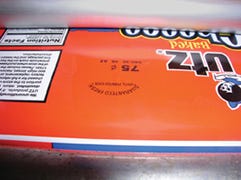
An overprinter on one of Utz's many bagging lines marks the bagstock with a price, a date and Utz-specific information such as a lot number or a manufacturer code.
In a day's time, packaging maintenance manager Bob Epley can visit all of the plants, sometimes more than once. Epley says the company uses plenty of flexible packaging. The snack bags are used for products targeted to delis, supermarkets and convenience stores range in size from 1- to 20 oz. Pretzels, cheese balls and snack/party mixes come in 22- to 48-oz clear polyethylene terephthalate canisters (from various sources). Epley says that the company also produces pretzel, cheese curl and corn and rye chip mixes in tall plastic canisters for clubstores.
Epley says the chip-bag lines usually run five days a week, 24 hours a day, without stopping. The flexible film bagstock [from Bryce Packaging (www.brycecorp.com) and Printpack (www.printpack.com)] is typically marked with two lines of code including a price, an expiration date, a lot number and a manufacturer code. Most of the canisters receive a pressure-sensitive label printed with three to four lines of coded information in either white or black ink. The label (from several suppliers) is then applied automatically on equipment from Quadrel (www.quadrel.com) to the canister. Depending on the product, some canisters are sleeve-labeled on systems from SleeveCo (www.sleeveco.com), and the sleeve material is coded directly by the thermal-transfer printers.
Read how BLOCKBUSTER VIDEO updated its packaging operation with new labeling and loading equipment at www.packagingdigest.com/ info/blockbuster
Moving from stamping machines to thermal-transfer overprinting a few years ago was an easy choice for Utz, which at that time, added six overprinters to its various plants. But for Epley and his crew, a key product-coding challenge was maintaining line speeds. "It doesn't take long to code a million packages a day," Epley says. "But we discovered missing or partial codes. That's a problem when running product at 140 bags a minute on four packaging machines. Sometimes, for a three-month project, we can run as many as 150 bags/min."
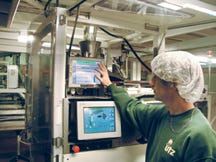
When Epley discovered the DataFlex line more recently, he began to investigate and really liked what he found. "The DataFlex caught my eye because it could print both in continuous and intermittent motion," he says.
The DataFlex's solid-state, clutchless ribbon-drive systems use bi-directional stepper motors. The DataFlex Plus comes equipped with a 3,281-ft-long ribbon, which translates to more time between ribbon changes. Both models function in continuous or intermittent motion, which makes them suitable for the continuous and intermittent operational formats on Utz's packaging lines. Typically, Utz uses the intermittent format to code the large canisters.
The DataFlex overprinters also feature a printhead and a ribbon that make contact with the flexible film substrate, the sleeves and the labels via miniature print elements under a glass coating that heat small areas of the print ribbon and transfer ink to the substrate. The print elements are program-controlled to create images, high-resolution codes, text and graphics in real time.
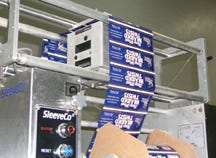
Some snacks are available in canisters that are sleeve-labeled. The label stock is coded by the overprinters prior to application.
The DataFlex printers are designed to continuously monitor ribbon tension to avoid faults and breaks that can interfere with production. This helps keep the printing ribbon in control, leaving 1 mm of space between prints for maximum ribbon use.
During its evaluation of the DataFlex, Utz conducted a trial involving a bagmaker, and Epley decided to include the DataFlex printer in the trial. Once the printing system was installed, Epley realized he had found the answer to the coding question. "The DataFlex hit the ground running at 120 bags a minute," he says. "That sold us, along with the fact that we could use the system on our intermittent packaging lines."
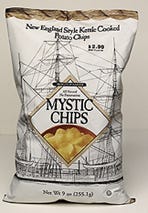
Today, the company has 12 DataFlex printers and six of the DataFlex Plus printers.
Packaging machine operator Steve Sneeringer likes the printers' intuitive, graphical user interface, which he says boosts uptime. "We wanted operator screens that are easy to navigate," he says. "Today, we just tap the touchscreen, create a different price and input an expiration date. And the DataFlex marks 250,000 bags using a single roll of ribbon, versus 6,000 to 15,000 marked with stamping equipment," he adds. Downtime has virtually been eliminated on lines where the DataFlex printers are stationed. "We just ran 22 million bags using the same printhead," says Epley. "We expect to see a return on the investment on the overprinters withinin a year." That's a tasty recipe for snack-packing success.
More information is available:
Videojet Technologies, Inc., 630/860-7300. www.videojet.com.
Bryce Corp., 901/369-4400. www.brycecorp.com.
Heat and Control, Inc., 415/871-9234. www.heatandcontrol.com.
Kliklok-Woodman, 770/981-5200. www.kliklok.com.
Printpack, Inc., 404/691-5830. www.printpack.com.
Quadrel Labeling Systems, 800/321-8509. www.quadrel.com.
SleeveCo, 706/216-3110. www.sleeveco.com.
About the Author(s)
You May Also Like


